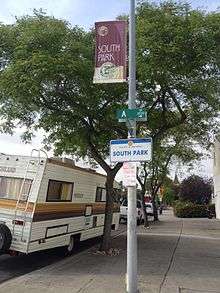South Park, San Diego

South Park is a neighborhood in San Diego, California located east of Balboa Park, north of the Golden Hill and Stockton neighborhoods and south of the North Park neighborhood. The northern boundary is Juniper Street.[1]
First registered as a subdivision in 1870, the South Park Addition was too far from Downtown San Diego to attract development until its purchase in 1905 by E. Bartlett Webster. The Bartlett Estate Company put in sidewalks, water, sewer, electricity, and other amenities and began selling lots, positioning the neighborhood as a "high-class residential district".[2] Further development was spurred by the 1906 opening of the South Park and East Side Railway, an electric streetcar line linking South Park with Downtown San Diego and making South Park the city's first streetcar suburb. In the 1910s, Golden Hill and the area now referred to as South Park became one of the many San Diego neighborhoods connected by the Class 1 streetcars and an extensive San Diego public transit system that was inspired by the Panama-California Exposition of 1915 and built by John D. Spreckels. These streetcars became a fixture of this neighborhood until their retirement in 1949, when the number 2 streetcar was replaced with the number 2 bus.[3][4]
South Park is now considered one of the major historic urban communities of San Diego and has long been proposed as a registered historic district.[5] Other historically significant neighborhoods not far from South Park include Burlingame, Golden Hill and Sherman Heights.
Description
South Park stands out in San Diego for its tree-lined streets, compact blocks, and walkable business district. Predominantly a single-family residence area with some small apartment buildings and bungalow courts, it is noteworthy for its fine and varied collection of Craftsman and Spanish Colonial Revival style homes built between 1905 and 1930. These include works by Irving Gill, William S. Hebbard, and Richard Requa. Many of the houses are historically designated and an official historic district has been in the pipeline for a number of years.
South Park has been gaining repute for its small businesses since the 1990s, and has long been home to a group of residents diverse in income, age, sexual orientation, and race. Pedestrianism, like in other urban mesa neighborhoods north of Balboa Park, is high relative to the rest of San Diego.[6] The elevation is about 200 feet above sea level but reasonably flat within most of the area. 30th Street forms its main business district and has been called the nation's best craft beer boulevard by Men's Journal.[7] The area is home to several churches, popular restaurants and cafes, grocery stores, taverns and wine bars, art galleries, a dog wash, a yoga studio and other business concerns. The main road running North and South through the neighborhood is 30th Street, which is marked for both cars and bicycles and is served by the number 2 line bus.[8]

South Park is bounded roughly by Balboa Park on the west, Switzer Canyon on the north, SR 15 on the east, and A street on the south. The southern portion of South Park shares the 92102 zip code with Golden Hill and other areas and the northern portion shares the 92104 zip code with North Park. South Park is home to the Albert Einstein Academy Charter School for German language immersion.
South Park has a reputation as a dog-friendly area, supported by one of the few designated dog parks adjacent to a residential area (at Grape Street).[9]
Neighborhood Name Controversy
There has been an ongoing controversy over whether or not South Park has historic significance insofar as its recognition as its own neighborhood independent from Golden Hill. Long time Golden Hill resident, community activist and owner/proprietor of the Big Kitchen restaurant, Judy Forman, known locally as "Judy the Beauty" calls her community Golden Hill. According to her “South Park is a name Republican real-estate people want. They want to be detached from Golden Hill because Golden Hill has an [image problem].” [10]
Old House Fair
The Old House Fair is an annual community event in South Park, centered on the intersection of 30th Street and Beech Street. It occurs on a Saturday in the middle of June. Vendors are primarily local businesses selling home furnishings and other items of interest for owners of vintage homes. Musical groups also perform on a stage on Beech Street.[11]
Pathfinders
South Park is home to one of the oldest residential treatments centers for alcoholism in California. Pathfinders of San Diego was founded in 1950 by a small group of men trying to stay sober. They opened a small storefront in downtown San Diego, where men living on skid row were offered a sober environment if they wanted it. Residences on Cedar and Dale Streets remain today as Pathfinders’ main recovery homes, capable of accommodating 40 men.
Quarterly South Park Walkabouts
The South Park retail and restaurant community hosts quarterly Walkabouts on Saturday evenings in March, July, October and December. Shops are open late, live music and refreshments are provided, and a free trolley carries attendees from Beech Street to Grape Street to Juniper Street.[12]
References
- ↑ http://www.city-data.com/neighborhood/South-Park-San-Diego-CA.html
- ↑ Greater Golden Hill Community Plan Update: Draft Historic Context Statement (PDF). June 2010.
- ↑ http://www.sdmts.com/MTS/timeline.asp
- ↑ http://www.chicagorailfan.com/sandate.html
- ↑ http://sohosandiego.org/histdistricts/southpark1.htm
- ↑ http://www.walkscore.com/CA/San_Diego/South_Park
- ↑ http://www.mensjournal.com/top-five-beer-towns
- ↑ http://www.sdcommute.com/Services/Route.aspx?r=2
- ↑ http://www.balboapark.org/in-the-park/grape-street-dog-park
- ↑ Manson, Bill. "Showdown in the Parks". San Diego Reader.
- ↑ http://www.theoldhousefair.com.
- ↑ http://www.southparkscene.com
External links
- South Park Scene -- businesses website
- Old House Fair
- Greater Golden Hill Planning Committee
- Official City of San Diego website map
- Greater Golden Hill Community Development Corporation
Coordinates: 32°43′16″N 117°07′41″W / 32.721°N 117.128°W